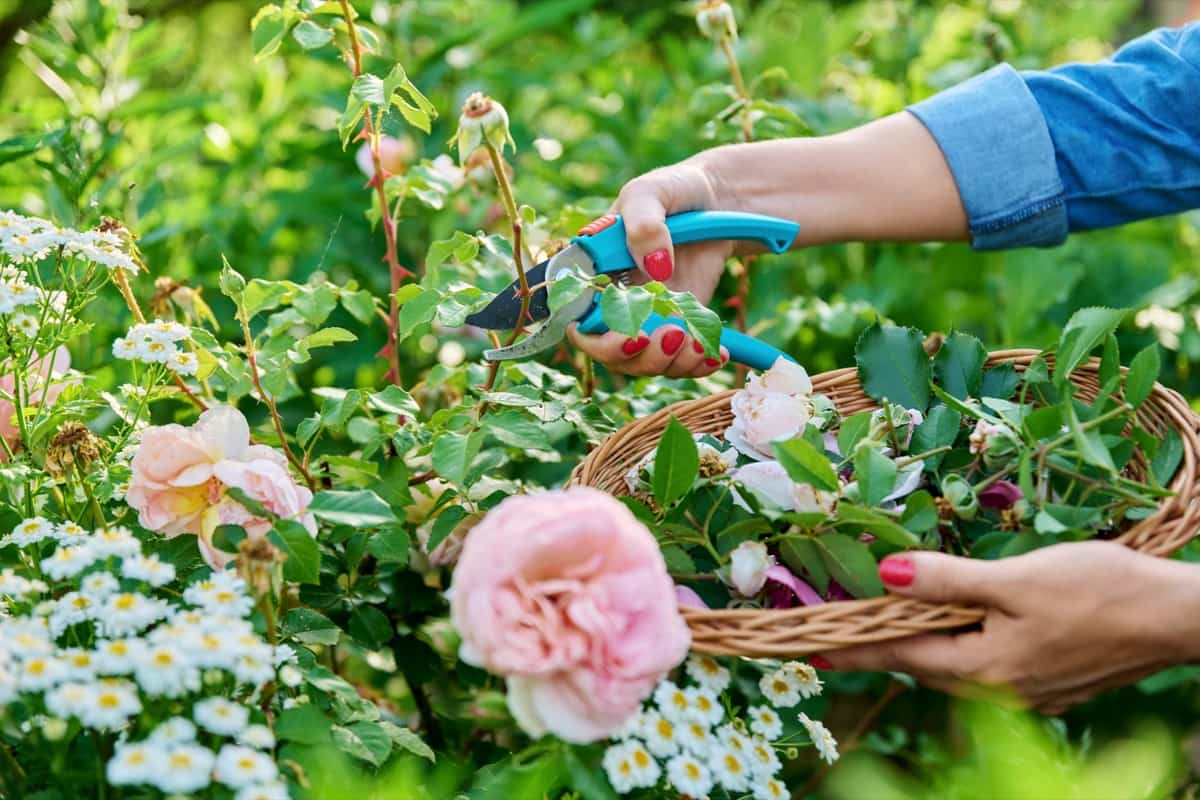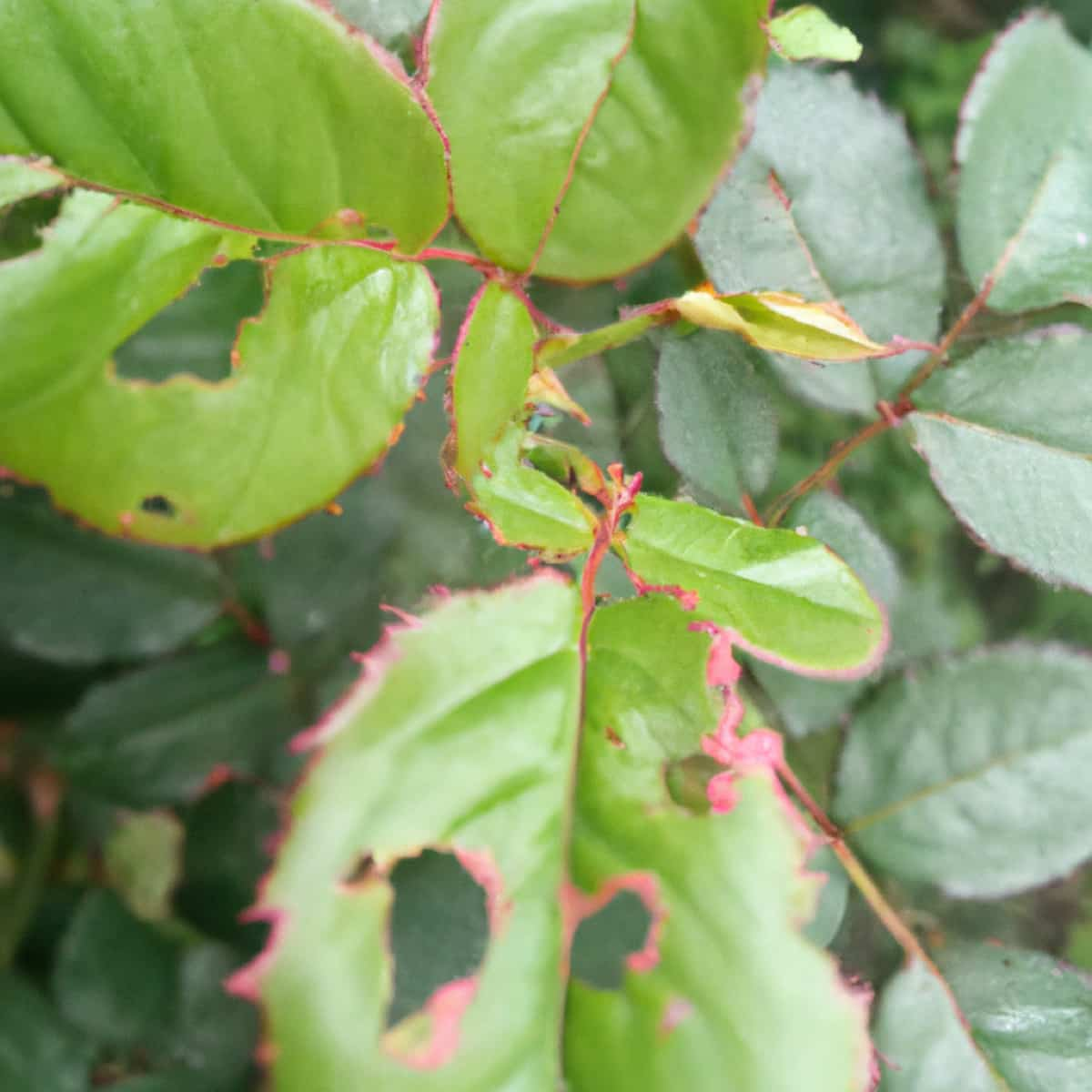Have you noticed that your rose leaves have holes in them? Despite what you might think, this happens quite often. It can be frustrating to find roses with holes, but these can occur for several reasons, and most of them can be easily fixed. Here’s what you should do if rosebushes’ leaves have holes.

8 Reasons for Holes in the Rose Plant Leaves
Common Pests Causing Holes in Rose Leaves
- Cutter bees will make half-moon-shaped notches in the leaves of some rose bushes. Spraying the rosebushes with a good insecticide with the culprit listed will help gain control of the situation.
- Caterpillars are another common pest of roses. Their damage usually presents as numerous irregular areas near the center of the leaves or entire leaves eaten. Most of these can be hand-picked off and dropped into a bucket of water. Likewise, the use of Bacillus thuringiensis is another nontoxic approach for them.
- Generally, rose slugs feed at night. Species of rose slugs can chew large holes or even the entire leaf, leaving only the midrib behind. Rose slugs can also be controlled with insecticidal soap and horticultural oil. Other insecticides labeled for homeowner use are acephate, bifenthrin, cyfluthrin, lambda cyhalothrin, permethrin, and spinosad.
Identifying Insect Damage: Holes in Rose Foliage
You most likely have scale insects on your rose plants if you see white, brown, red, or black scale-like dots on their petioles. Although these insects do not make large holes in the leaves, they can weaken or kill roses by sucking out the nutrients from their leaves and petioles. Since these insects are difficult to repel, you should always monitor your roses and remove them as soon as you see them.
The insects aphids and thrips attack many plants, so if you have a garden, keep an eye out for them. They don’t cause a lot of damage in small numbers, but as their numbers increase, they can cause more damage. The best way to get rid of aphids is to spray them directly with a garden hose. Additionally, horticultural oil sprays can be applied to infected areas to control scale growth.
Hole-ridden Rose Leaves: Causes and Solutions
Causes
- Insects: Insects such as beetles, caterpillars, and aphids can cause holes in rose leaves as they feed on the plant.
- Disease: Fungal diseases such as black spots and powdery mildew can weaken rose leaves and cause them to develop holes.
- Environmental factors: Extreme temperatures, drought, and excessive moisture can all contribute to hole-ridden rose leaves.
Solutions
- Insecticides: Using insecticides can help control insect infestations that cause holes in rose leaves.
- Fungicides: Fungicides can prevent and treat fungal diseases that cause holes in rose leaves.
- Proper care: Providing your roses with proper care, such as regular watering and pruning, can help prevent environmental factors from causing holes in the leaves.
Rose Diseases Leading to Leaf Perforation
Rose rust: The upper surface of the leaves is affected by yellow spots, while the underside is affected by reddish-brown pustules. The spots may turn brown as the disease progresses, and the leaves may become distorted. The spots will eventually form small, round holes.
Black spot: On the upper surface of the leaves, it causes black spots that are small, circular, and dark in color. A disease that progresses may cause the spots to grow larger and the leaves to become distorted. Small, round holes will eventually form as a result of the spots.
Rose leaf curl: As a result, rose leaves become curled or distorted, yellow spots appear on their upper surfaces, and reddish-brown spots appear on their undersides. Spots may become larger, and the leaves may become distorted as the disease progresses. Small, round holes will eventually form in the spots.
Holes in Rose Leaves: Nutrient Deficiencies as a Factor
Holes in rose leaves can indicate nutrient deficiencies in the plant. When the plant lacks certain nutrients, it becomes more susceptible to pests and diseases. In particular, a potassium deficiency can lead to small, circular holes in the leaves. This is because potassium is important for maintaining strong cell walls in the plant tissue. Other nutrient deficiencies can also lead to holes in rose leaves. For instance, a lack of magnesium can cause yellowing of the leaves, leading to holes as the plant weakens.
In case you missed it: 8 Reasons Why Your Roses Drop Their Flowers: Treatment, Prevention, and Solutions

Similarly, a calcium deficiency can cause the leaves to become distorted, leading to holes. To prevent nutrient deficiencies and holes in rose leaves, it is important to ensure that the soil is rich in organic matter and that the pH level is appropriate for roses. Regular fertilization with a balanced fertilizer can also help to provide the necessary nutrients for healthy growth and development.
Environmental Factors and Hole Formation in Rose Foliage
Pruning.: Roses can be pruned to maintain their shape and to promote healthy growth. The plant can, however, become weak and more susceptible to disease and pests if pruning is done too severely or too often. When pruning, use sharp, clean tools and be sparing.
Inadequate watering: Frequently watering roses will prevent the leaves from becoming dry and brittle, which leads to disease and pest problems. A lack of soil nutrients also results from inadequate watering, further weakening the plant. Apply
Improper fertilization: Rose leaf holes can also result from it. For roses to grow and stay healthy, they need a balanced supply of nutrients. Fertilizers applied in excess can burn the leaves, making them brittle and susceptible to disease and pests. In contrast, too little fertilizer may not provide the nutrients the plant requires.
Preventing Rose Leaf Damage
- If you notice any insects, use an appropriate insecticide or biological control method to eliminate them.
- Ensure adequate air circulation around your plants, avoid overhead watering, and remove any infected leaves immediately.
- Practice good sanitation habits, such as regularly disinfecting your pruning tools and immediately removing any infected plant material.
- To prevent nutrient deficiencies, ensure your plants receive adequate nutrition through fertilization and soil amendments.
- To prevent overwatering, ensure proper drainage in your plant’s container or planting site and reduce watering frequency during periods of high rainfall.
- Ensure your plants receive adequate moisture, especially during drought.
- Support your plants during high wind or hail periods, and avoid planting your roses in areas prone to severe weather conditions.
- Avoid using herbicides near your roses, and ensure that any herbicides used are labeled safe for use around roses.
- Environmental stress like drought, heat, or cold can cause holes in rose leaves by weakening the tissue and making it more susceptible to damage.
Rose Leafcutter Bees and Their Impact on Leaf Integrity
They are named for their unique ability to cut perfect circles out of rose leaves, which they use to create their nests. These bees are important pollinators for various plants, including rose bushes. However, their habit of cutting perfect circles out of leaves can also impact the integrity of the plants they visit.
When rose leafcutter bees cut circles out of rose leaves, they can weaken the overall structure of the leaf. This can make the plant more susceptible to wind, rain, and other environmental damage. Additionally, if the bee cuts too many circles out of one leaf, it can cause the leaf to die prematurely. This can be especially harmful to young or newly-planted rose bushes, which may not have the resources to recover from the damage.
- If you spot any leaves with holes, remove them immediately. This will help prevent the pest from spreading to other parts of the plant.
- If this pest infestation is severe, use insecticidal soap to control rose leafcutter. Follow the instructions on the label carefully.
- To prevent future infestations, keep your garden clean and tidy. Remove fallen leaves or debris from the ground, which can provide a breeding ground for pests.
In case you missed it: 10 Reasons Why Your Roses Aren’t Blooming: Treatment and Solutions

Conclusion
In conclusion, there are several reasons why roses have holes in the leaves. Identifying the cause of the problem is essential in treating and controlling it. Follow the treatment mentioned earlier and control methods to keep your roses healthy and beautiful.
- Feed Your Flock for Less: Top 10 Tips to Save on Chicken Feed
- Ultimate Guide to Ossabaw Island Hog: Breeding, Raising, Diet, and Care
- Hatching Answers: The Top 10 Reasons Your Chickens Aren’t Laying Eggs
- Eggs and Economics: Breaking Down the Cost of Raising Backyard Chickens
- Defend Your Greens: Proven Methods to Keep Iguanas Out of Your Garden
- Ultimate Guide to Cinnamon Queen Chicken: A Comprehensive Guide for Beginners
- Ultimate Guide to California Tan Chicken: Breeding, Raising, Diet, Egg-Production and Care
- Ultimate Guide to Marsh Daisy Chicken: Breeding, Raising, Diet, and Care
- 10 Types of Chicken Farming Businesses You Can Start for Profits